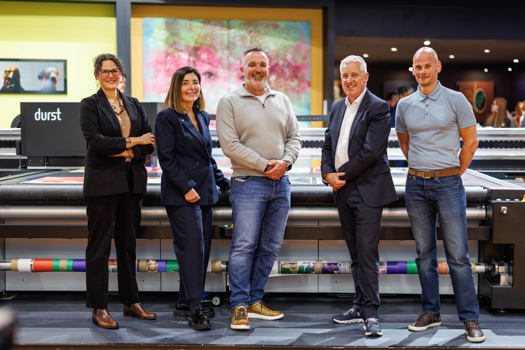The day is marked globally on 8 March, and aims to celebrate the social, economic, cultural and political achievements of women. It also marks a call to action for accelerating gender parity.
Royal Mail has been using a special postmark to highlight the event.
Explaining the #ChooseToChallenge theme, IWD stated: “A challenged world is an alert world. Individually, we're all responsible for our own thoughts and actions – all day, every day.
“We can all choose to challenge and call out gender bias and inequality. We can all choose to seek out and celebrate women's achievements. Collectively, we can all help create an inclusive world.”
The printing industry has historically been male-dominated, but there is now a far wider range of opportunities for women across print workplaces where roles and opportunities have been dramatically altered by technology.
Printweek asked a selection of women in print about their thoughts on International Women’s Day, after a year like no other.
Zoe Deadman, managing director, KCS Print
“Covid, whilst challenging, has allowed us the opportunity to leap out of the 90s and jump headlong into the 21st century in terms of smarter working practices. Enforced home working, combined with the greater burden of childcare, has really road tested the opportunity for flexible working and proven that it is possible, although challenging, to do both roles.
“The burden of childcare though is still a feature which has the biggest impact on holding women back in their careers whether this is in print or any other sector. The latest data from Eurostat shows that women do three hours 50 mins of household and family care per day whereas men do two hours 20 mins. Until this statistic changes women will continue to be held back in their careers as the patriarchal perception of women as the main care giver continues.”
Tanya Dunbar, managing director trade books, CPI UK
“I am supportive of Women’s Day, and recognise its importance in celebrating the achievements of women, however I personally have been exceptionally fortunate to be in an industry, and worked for two key players in that industry, St Ives and CPI, who have not made gender an issue, in any way. I won’t pretend it hasn’t been challenging balancing working and bringing up my daughter, however the support I got made it possible for me to succeed.
“As we are manufacturing physical products, it makes it difficult to see how the last year will significantly change our approach to working. The vast majority of our employees are shopfloor based, and although some of our admin functions can more easily be managed from home, a number of our office based roles lose something by not being on site and being able to engage in person with their shopfloor colleagues. I’m sure in many industries home working has opened up different opportunities, however as a manufacturer, it is difficult to see how we can make any substantial changes without affecting the service our customers value, and expect from us.
“Also I’m not convinced home working has necessarily benefited our female employees who have children, I think they have been given a near impossible task, working whilst managing childcare and home schooling. I am amazed and impressed by how they are still functioning on both fronts, a superhuman effort.
“The demographic of our workforce strongly swings towards men, mostly due to the roles on the shopfloor which have historically been done by men. I would be delighted if we could balance this out and have a more equal split between men and women, however when recruiting we are always looking for the best person for the job in question, someone who shows both aptitude and the right attitude, which makes their gender irrelevant.
“Where I do believe we need a sharper focus is exploring how we attract young people, especially women, into the print industry. So many skills have been lost over the years due to the demise of countless print businesses and I don’t think we have done enough as an industry to ‘hook in’ a younger audience. We need to invest more in apprentices, taking the time to showcase print as an attractive career, alongside this we hope the new government backed Kickstart scheme will open up our industry to many more school leavers. I believe that’s where we can start positively changing our employee demographic, both in terms of gender and also age.”
Sarah Kilcoyne-Guilliam, head of sales and integration, Route 1 Print
“I think a lot of the changes will affect everyone, not just women but we do have a great opportunity to use the changes to try and get more women into the industry!
“With the shift to remote working, now more than ever companies have been looking at technological solutions to aid their print procurement. We’re making the industry more inviting to all walks of life including women, younger people and those currently in other sectors. I think it’s a great opportunity for everybody, especially those who we have struggled to entice into the industry over the years.”
Karly Lattimore, managing director of training, BPIF
“Having spoken to some of our female trainers the consensus is that there will be more opportunities for women in the industry for a couple of reasons.
“One, the introduction of the government’s plan for jobs initiatives, ie incentives for taking on apprentices, Kickstart, traineeships should all help women gain skills to secure good jobs in the industry. This coupled with the willingness of companies to adapt more flexible working conditions could be a huge help to women who may have taken time out of the industry for whatever reason to encourage them back.
“Two, unfortunately there are still some companies even today where certain roles have been really dominated by men i.e. men were skilled printers or finishers whereas women were unskilled table hands or packers. COVID came along it was pretty much all hands to the pumps for most companies and employees have had to become more flexible in their roles to help out, even though this relates to both sexes I think women will benefit more from new skills gained, purely because some were unskilled to start with, it’s just a shame that it’s taken a pandemic for some companies to give more opportunities to women.”
Diana Levy, print and production services manager, Royal Horticultural Society
“I believe that the changes we have seen during the last 12 months will result in better and increased opportunities for women in the print workplace. Women have been at the forefront of looking after household chores, home schooling, caring for vulnerable members of their families and, for many, working at the same time. That requires a level of multi-tasking, organisation and time-management that would be of benefit within any role. Whereas women with children in particular may once not have been considered for many roles, whether as buyers or in print suppliers, due to a perceived lack of ability to commit in the same way as male colleagues, what the pandemic has shown is that it only takes small changes to working practices to enable women to be effective at home and at work.
“Having the flexibility to work outside of the old 9 to 5 structure and making working from home part of normal operations rather than an exception has in many cases resulted in increased productivity, a better work/life balance, and happier staff. The growth in, and success of video conferencing means that women can take on sales roles that they may not have previously considered viable as customer relationships can be built virtually, they no longer rely on travelling around the country for face-to-face meetings. The only area where change may prove difficult is within press halls or binderies where it’s still necessary to be physically on site and the changes that many of us have seen since March 2020 haven’t been possible. There are, though, no longer any excuses for not being flexible in who companies consider for any other roles and how staff can work.”
Kelly O’Sullivan, senior print and publications manager, Sainsburys Argos, and founder of the Victoria Print Network
“One thing that I think Covid has done is make business leaders rethink the possibilities of working flexibly. Through my Victoria Print Network and the round table discussions we have, it often comes up that a barrier to women progressing in our industry is that it’s so difficult to balance having a family and having a career.
“Whenever I talked to business leaders in our industry about working flexibly, they often dismissed it as not practical for print companies. But working through Covid has shown that we can work from home or work part time/adjusted hours and still deliver, so I really hope that some of that continues as we head towards to a new normal. Hopefully one where it’s easier for women (and indeed men) to agree a format of flexible working with their employers that’s a win for both parties and means that we can truly tap into the female talent in our industry and even help us attract more.”
Bettine Pellant, CEO, Picon
“Working patterns have changed during the pandemic. As people have juggled home education and work, employers have learnt to be much more flexible about the hours people work and have learnt to trust staff to work conscientiously from home. It hugely accelerated the take up of online meetings and this convenient, time- and travel cost-saving option could be retained alongside face to face meetings in future.
“These changes will impact on women in management, sales, support and administrative roles. If a woman is responsible for dropping off and collecting up school age children, the ability to work from home and for longer hours with no commute could be a great advantage. Equally, if men are asked to work from home more, they may be seen at the school gates more and that could free up their partner or spouse to work away or for longer.
“That said, some women will still prefer to work in the office with the opportunities for learning and social intercourse which that offers. The pandemic will have helped individuals to identify how they work best and what motivates them to work aside from income. My guess is that many businesses will offer “blended” or “hybrid” options.
“Women (and men too) on the manufacturing side will see less change in their place of work but the workplace will have changed in that the emphasis on hygiene and environmental improvement is likely to be the legacy of the pandemic.”
Nicole Spencer, managing director, RMC Digital Print
“The main changes in ways of working have been that working is more flexible and people have been able to work from home. It’s also much more commonplace to hear people’s children in the background when taking business calls or doing video meetings. This has resulted in a more flexible workplace for people which I assume will continue long after Covid restrictions. We could argue that this will improve opportunities for women in the print workplace but that is assuming that these women have children and are responsible for the majority of the childcare. During the various lockdowns and restrictions, I have been in the workplace whilst my husband has been at home doing the childcare and home schooling. So, I’ve not needed this extra flexibility as much as some of my friends and peers have.
“Our staff who are based in production roles haven’t been able to work from home but there has still been a need for more flexibility with working hours as people have needed time off for childcare, appointments and time to support family members who have been isolating. This flexibility will continue into the future and I suppose it could be argued that a more flexible way of working within production will create more opportunities for women if they have constraints on their working hours due to home life, but again, this is the same for men.
“Although print is a fairly male dominated industry, I do think there are many opportunities for women, and it is an inclusive industry. I hope that more young women will look at print as a career and be welcomed into the industry just as I was nine years ago.”
Joanna Stephenson, managing director, PHD Marketing and co-founder, Women in Packaging
“The acceptance of remote and more flexible working enforced by the pandemic certainly creates a working environment that women - as the most traditional carers of children and elderly parents - can thrive in. The 9-5 routine with daily commute has morphed into a more fluid work day where women can more easily balance the demands on their time. One can only hope that the tradition of full-time office working does not re-emerge and that more flexible arrangements will continue for women to stay in the workplace for longer and therefore further their careers.”
International Men’s Day will take place on 19 November.










